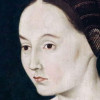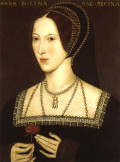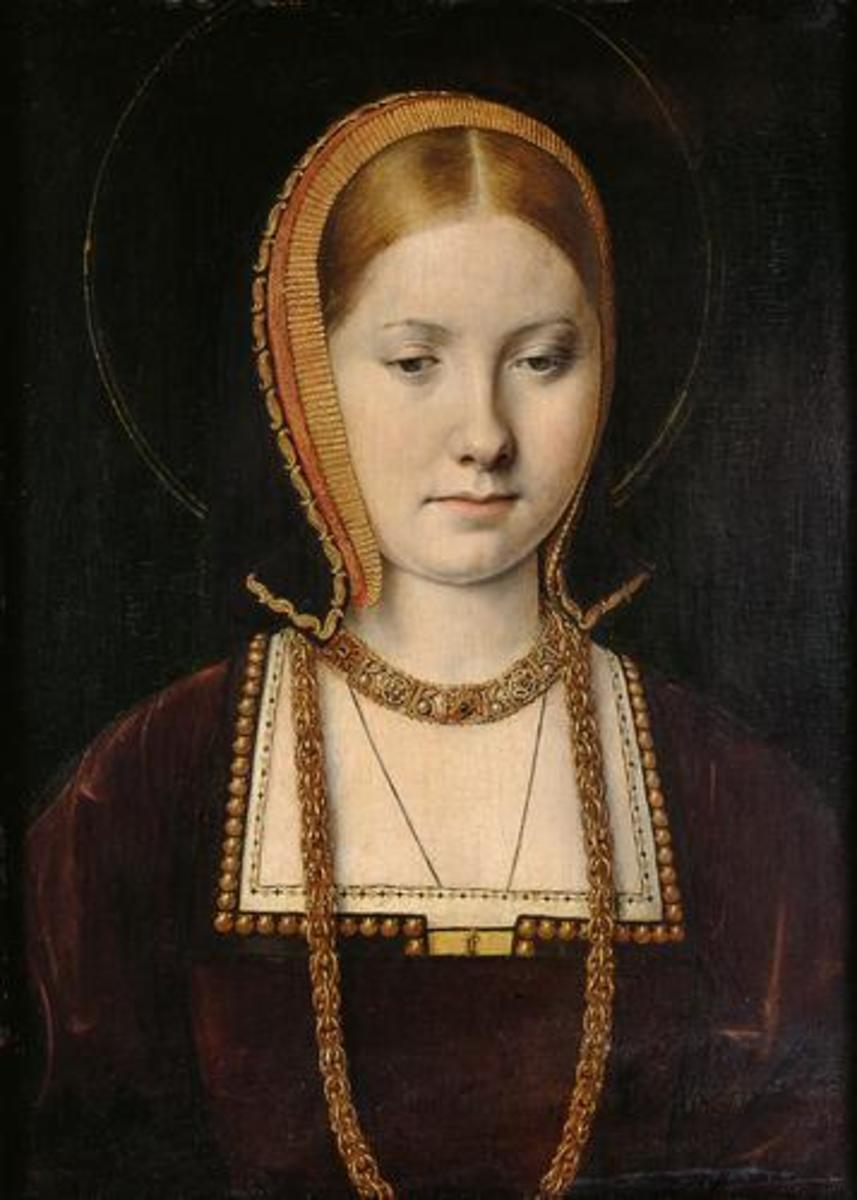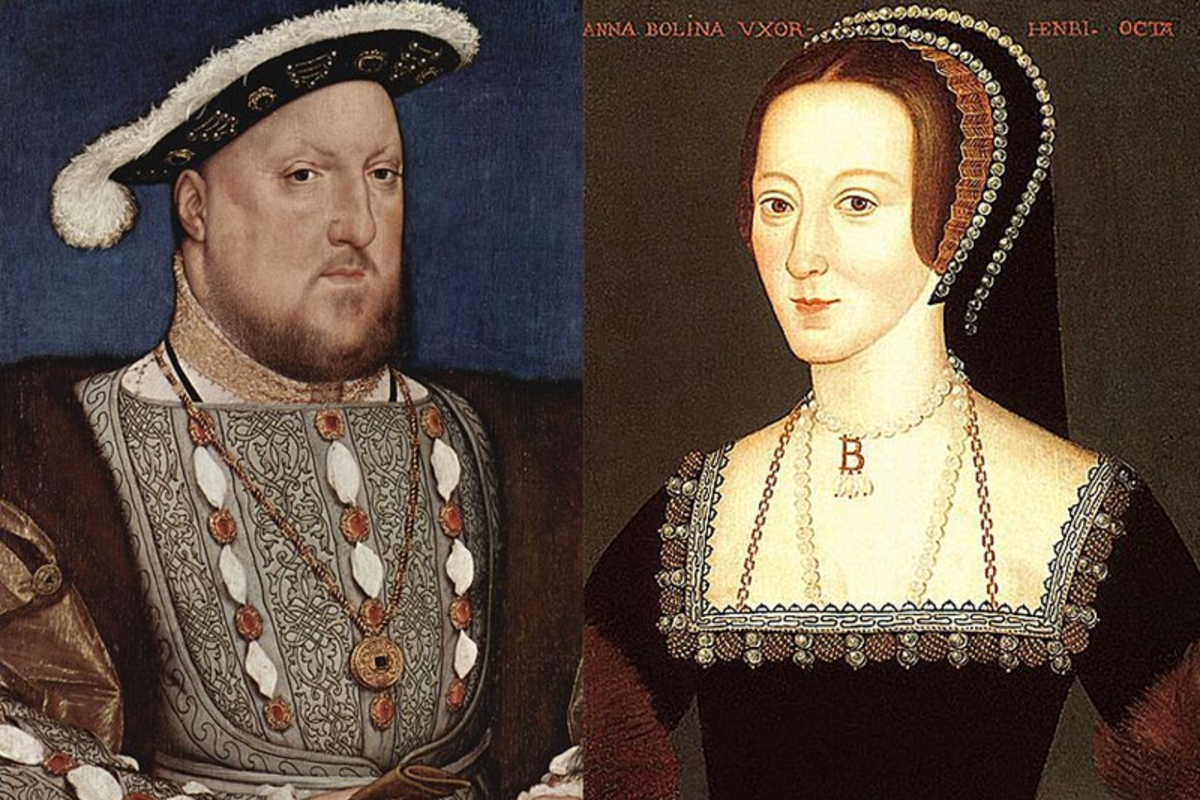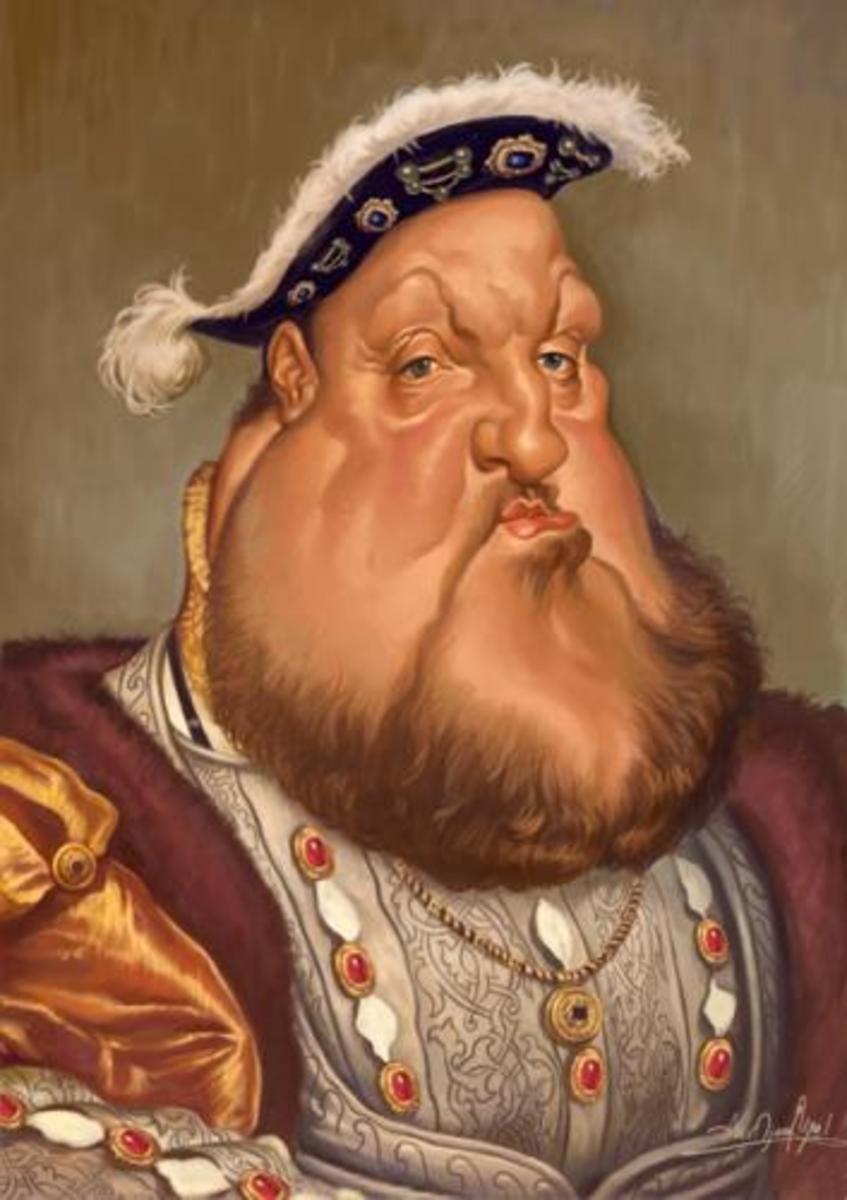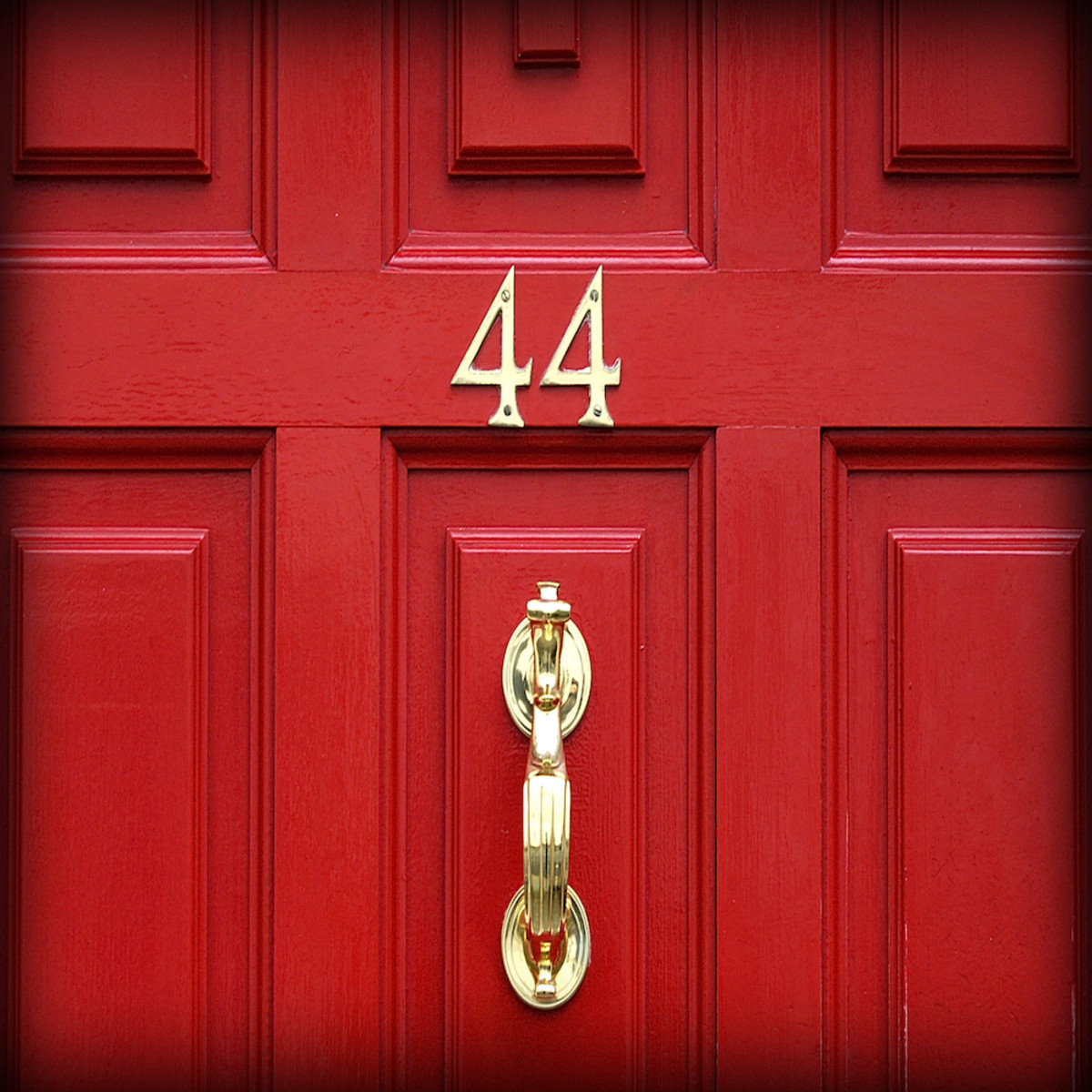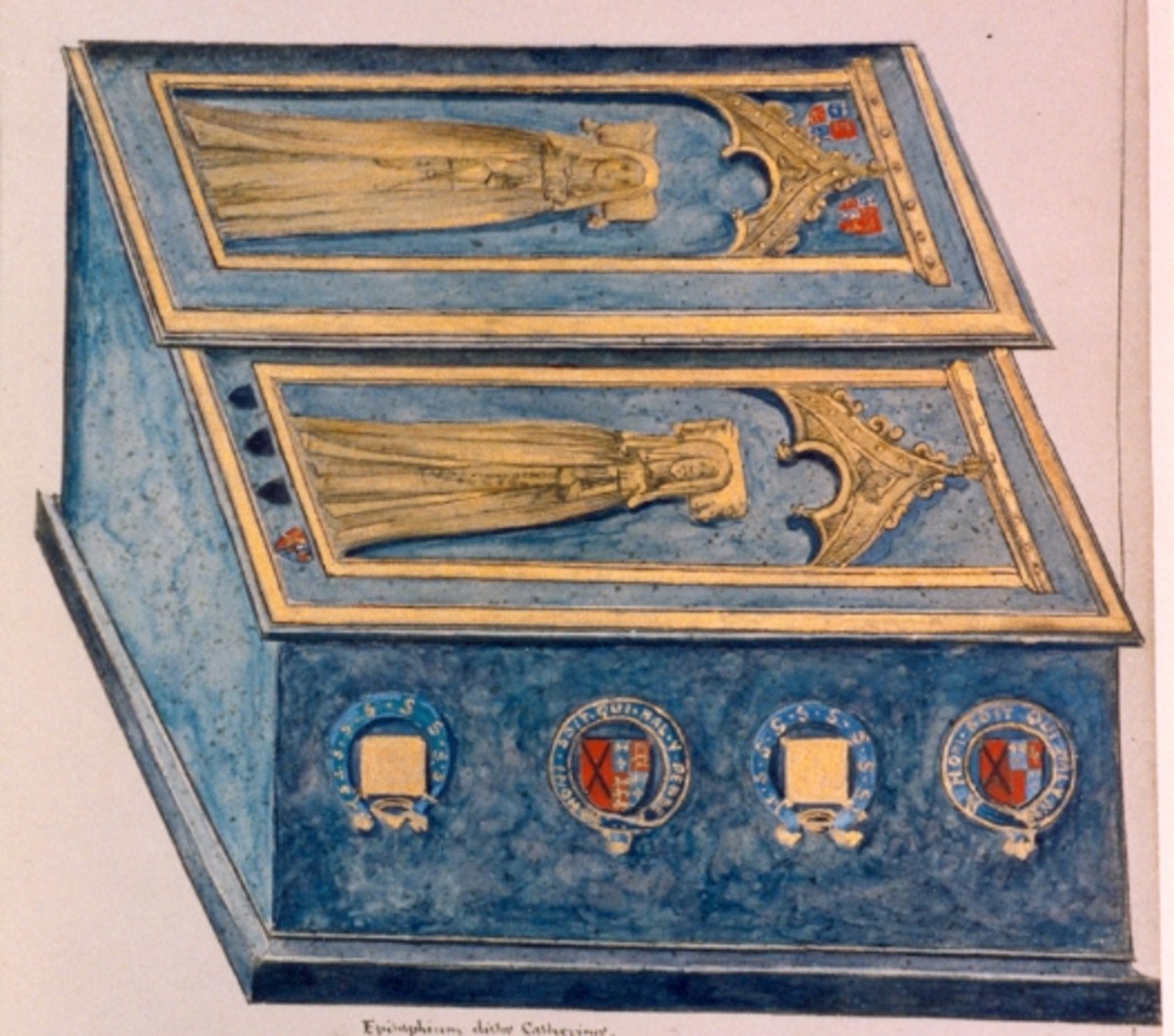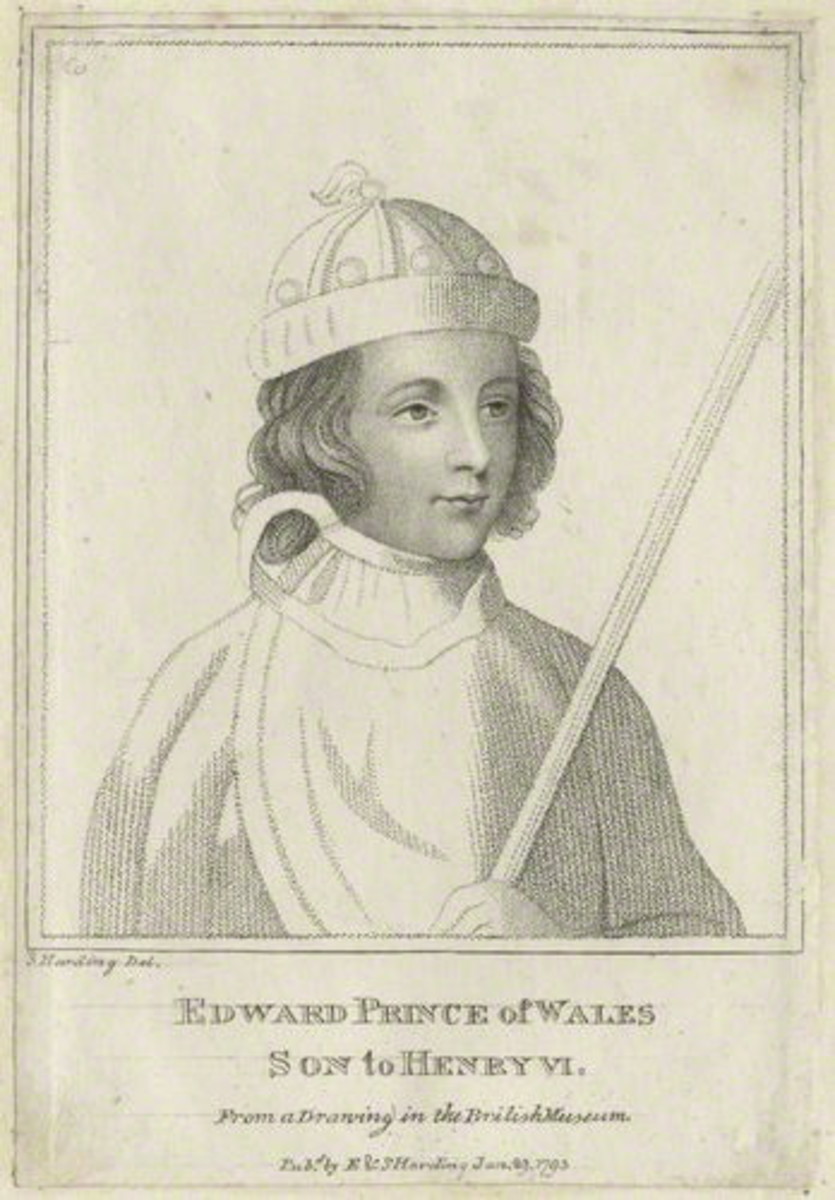Anne Boleyn
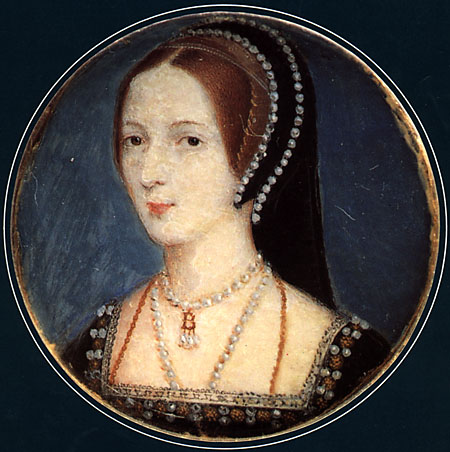

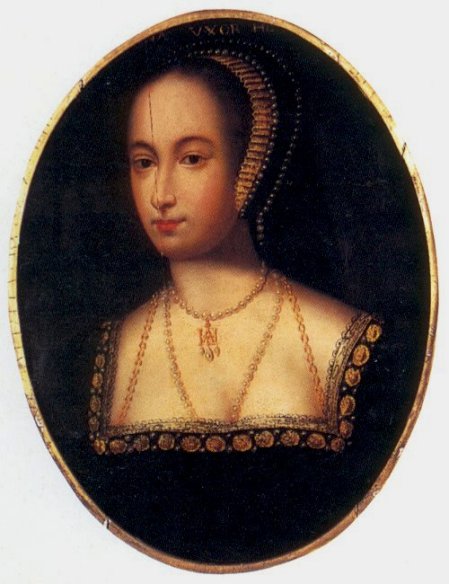
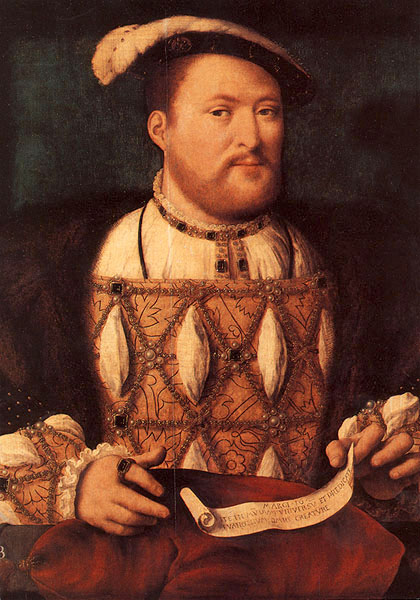
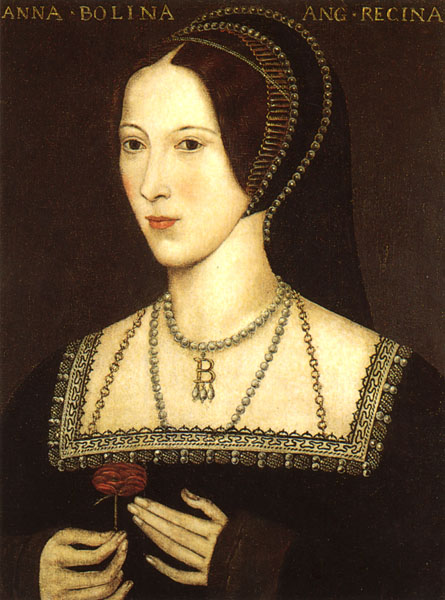
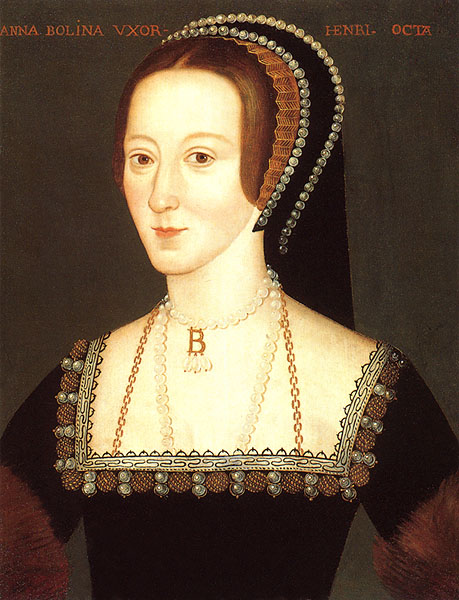
The Second Wife
There have been different dates put forward for the birth of Anne Boleyn, as there are no records. She was probably born between 1500 and 1509. Her parents were Thomas Boleyn and Elizabeth Howard. Her father came from a line of merchants whilst her mother was a daughter of the second Duke of Norfolk and sister to the third Duke. Anne had two siblings - Mary and George.
In 1513 she was placed in the household of the Archduchess Margaret, Regent of the Netherlands, as a maid of honour. She began learning French and would eventually become fluent in the language. The following year in autumn she transferred into the service of King Henry VIII's sister Mary when she went to France to marry the French King, Louis XII. After Louis died, Queen Mary returned to England, but Anne remained at the French court in the household of the new King's wife Queen Claude. She may have been at The Field of Cloth of Gold in 1520 as one of Queen Claude's ladies, though her name is not listed.
Anne was recalled to England in 1521 to prepare for an arranged marriage with James, Lord Butler, son of the eighth Earl of Ormonde. It seems she had been sufficiently popular at the French court for King Francois I to complain that 'the daughter of Mr Boullan' was leaving. When Anne returned to England, she was placed at court as a lady-in-waiting to Queen Katherine of Aragon.
What was this young woman who had spent so long in a foreign court like? Anne had dark eyes that were almost coal-black and hair that was just as dark. She was slim, had an olive complexion, and was of 'middling stature'. She wasn't the conventional beauty of peaches and cream complexion and blonde hair. She was not the docile woman expected of her time. She was fiery, she was clever, she was tantalising. She was different.
Her first recorded appearance at the English court was in early March 1522. She took part in a masque, playing the part of 'Perseverance'. It may have been an indication of her personality, as the King's sister Queen Mary, now the Duchess of Suffolk, played the part of 'Beauty', and she had been considered as one of the most beautiful princesses in Europe.
The marriage with James Butler fell through and Anne was left free again. Many arranged marriages fell through, so it does not mean that Anne's character was blemished by it. Anne had admirers - the poet Thomas Wyatt, but he was married, and Henry, Lord Percy, the son of the Earl of Northumberland. Percy quickly fell in love with Anne, and she apparently returned his feelings.
According to William Cavendish, who had been in the service of Cardinal Thomas Wolsey the Chancellor, Anne and Percy had agreed to marry. When Wolsey found out he summoned Percy and said, 'I marvel not a little at thy peevish folly that thou wouldst tangle and ensure thyself with a foolish girl yonder in the Court - I mean Anne Boleyn'. Percy stood his ground against the Cardinal, who summoned Northumberland to court. Percy received a furious tirade from his father; the marriage with Anne was broken off and Percy was quickly pushed into an arranged marriage. Soon Anne would forget Henry Percy when King Henry VIII began to show interest.
The beginning of the King's love for Anne Boleyn is not dated. He wrote her a series of love letters in his own hand, despite the fact that he hated writing his own letters. On New Years' Day 1527 it appears that Henry and Anne agreed to marry. The King was in his mid-thirties and Anne in her twenties. Anne Boleyn would be Henry VIII's greatest passion, and he wanted her to be his wife - but he had to get rid of Queen Katherine first.
On the 17th of May that year, Cardinal Wolsey opened the Secret Trial of the King's marriage, known as the 'Great Matter'. King Henry was now convinced that his marriage to Katherine of Aragon was invalid of the grounds of Leviticus 20:21, which stated that it was a sin to marry your brother's widow, but this depended on the marriage having been consummated. Queen Katherine was adamant that it had not, and that she had been a virgin when she married Henry.
In the summer of 1528, there was an outbreak of the mysterious sweating sickness, in which many people died, including Anne's brother-in-law, William Carey. Anne herself contracted the illness, which had a high fatality rate; she survived.
Cardinal Campeggio was sent from Rome, arriving in London on the 7th of October 1528, as a joint inquisitor with Cardinal Wolsey into the King's marriage.
The following year, there was a court dinner to celebrate St Andrew's Day, and Queen Katherine took the opportunity to cause an argument over the matter of whether or not she had been a virgin when she married Henry. The King left the argument in a foul mood and sought solace from Anne, who in her own turn became upset with Henry, claiming that someday Henry would go back to Queen Katherine and she would have nothing. The King tried to pacify her, as he always did when she lost her temper.
On Christmas Eve 1530, Queen Katherine told King Henry that he was setting a bad example by keeping Anne in his company. The King responded that he was not living in sin with Anne and would marry her, whatever the Pope or Katherine said. He abandoned Katherine the following year, and never saw her again.
Janyary 1531 saw Henry named as Supreme Head of the Church and Clergy of England 'in so far as the Law of Christ allows'. This meant that the title would be practicaully useless if the final part was taken seriously. On the 15th of May 1532 he would be acknowledged as Supreme Head of the Church of England without reservation.
In March 1531, the ambassador Chapuys said that Anne and her father were more Lutheran 'than Luther himself'. He was hostile to Anne Boleyn because he was an ambassador for Emperor Charles V, Queen Katherine's nephew. He also admired Queen Katherine and despised Anne's Reformist tendencies. Jean du Bellay, Bishop of Bayonne and a special ambassador for Francois I, wsa more sympathetic - Anne had a love of all things French, and of course any signs of hostilities between King Henry and the Emperor made it more likely that England would ally with France.
William Warham, the Archbishop of Canterbury, died at the age of seventy-six in August 1532. It was decided that Thomas Cranmer should be appointed. He sympathised with the King's side in the Great Matter, and he was a Reformer like Anne. He submitted to the decision rather unwillingly as he had no desire to be an Archbishop - particularly because he was secretly married, which was against the rules.
On the 1st of September 1532, Anne was created the Marquess of Pembroke. She received five manors in Wales and eight in England. Arrangements were being made for the King and Anne to travel to Calais and meet King Francois. Queen Katherine was forced to surrender her jewels for the occasion, so that Anne could wear them.
There as an issue on who should receive Anne. Francois' wife Claude had died some years before and he had since remarried Eleanor, the sister of Emperor Charles V. Queen Eleanor refused to receive Anne because she was a niece of Queen Katherine. The French King's sister, Marguerite d'Angouleme, would have been suitable to receive Anne, but Francois wanted his second son Henri to marry the Pope's niece Catherine de' Medici, and did not want to rock the boat with the Pope too much.
On the 21st of October, King Henry met with King Francois at Boulogne and was entertained for four days in French territory whilst Anne stayed in English territory at Calais. On the 25th King Francois came to Calais as a guest of King Henry and Anne, spending a further four days there before he returned to France.
Some time before the end of 1532, Henry VIII finally made love to Anne Boleyn after years of pursuit. They married secretly on the 25th of January 1533, and the news leaked. Anne was also pregnant.
Katherine of Aragon was informed on the 9th of April that the King had remarried and she was no longer Queen but the Princess Dowager - the title she had as the widow of Prince Arthur, who had died over thirty years before. Three days later, Anne appeared for the first time as Queen.
In May, Archbishop Cranmer declarred the marriage of Henry VIII and Katherine of Aragon invalid. On the 29th of that month, Queen Anne wore a dress made of cloth of gold as she travelled by water from Greenwich to the Tower of London, and was accompanied by fifty barges. King Henry greeted her at the Tower. Two days later, Anne made her formal entry into London.
The 1st of June was the coronation. Queen Anne wore a gown of crimson satin, a robe of purple velvet furred with ermine, and a high collar tied with gold tassels. After the coronation in Westminster Abbey, the Queen was conducted to Westminster Hall for the celebratory banquet. Ten days later on the 11th, Pope Clement VII declared Archbishop Cranmer's judgement void, ordered Henry to put away Anne, stating that any child of theirs would be illegitimate, and for good measure, excommunicated the King.
Just before Queen Anne went into confinement in late August, she and King Henry quarrelled - quite possibly over another woman. When the Queen attempted to upbraid the King using harsh words, he did not try to pacify her for once. He told her that 'she must shut her eyes, and endure as her betters had done'. It was a reference to Katherine of Aragon, and he was implying that she had been a better wife and woman than Queen Anne. He also told her that it was 'in his power to humble her again in a moment more than he had exalted her'. Anne had been warned.
After just over a week of being in confinement, Anne gave birth on the 7th of September. It was not the long-awaited son that she had promised Henry. It was a girl, and her name was Elizabeth. Whilst the King and Queen were good at hiding their disappointment, the letters announcing the birth had to be edited to read 'Princes[s]' instead of 'Prince'.
In early November that year, the Queen's uncle Norfolk went to see the King's daughter Princess Mary. Norfolk told her that she was to go into the service of Princess Elizabeth. It was felt that the prime mover behind this humiliation was Queen Anne. The ambassador Chapuys said, 'She will do the worst she can'.
By January 1534, Anne was pregnant again, but it failed; she never went into confinement so it was probably a miscarriage. In March that year, the Pope declared the marriage of King Henry and Queen Katherine valid. It was good news for Katherine's peace of mind, but it was too late. On exactly the same day, the Act of Succession had its third reading. It formally declared the validity of the marriage of King henry and Queen Anne, together with the right of their issue to succeed instead of Princess Mary, who was now Lady Mary.
She was also different from Katherine in matters of religion. Katherine of Aragon followed the Christian beliefs that she grew up with, but her beliefs would now be called Catholic, whilst Anne Boleyn was a Reformer - she had more Protestant tendencies. Early on, King Henry and Queen Anne would enjoy their theological debates, though when he was falling out of love with Queen Anne, he began to dislike argumentative women like her.
In late 1535 the King visited the Seymours of Wolf Hall. It was whilst he was there that he became attracted to Sir John Seymour's daughter Jane, a lady-in-waiting to the Queen. Shortly after his return from the visit, Anne became pregnant again.
News arrived at court on the 8th of January 1536. Katherine of Aragon was dead. The King and Queen celebrated the news by dressing in yellow. On the 24th that month, the King was jousting when he fell from his horse. The Queen was not present but when she was told she was badly shocked. Katherine of Aragon's funeral took place five days later, and Queen Anne suffered a miscarriage on the very same day.
Anne had now miscarried at least twice and had only produced one girl. It was taking the form of a pattern that King Henry VIII was all too familiar with. Now that Katherine was dead, Henry was technically a widower by Catholic standards - and therefore free to remarry. He'd had enough of Anne with her fiery temper, and he was now in the mood for something, or someone, more docile. The year 1536 would be the year of the mouse.
The King and Queen presided over the May Day jousts as usual. Henry behaved as normal towards Anne when he had already decided her fate. He left the jousts early, taking Sir Henry Norris with him. As he had with Katherine, he left Anne that day without a word and never saw her again.
Henry questioned Norris on their way back from the jousts, and the next day Norris found himself being taken to the Tower of London. A court musician, Mark Smeaton, had been taken to the Tower on the day of the tournament. The day after the tournament, Queen Anne was interrogated and then taken to the Tower.
The King was determined not to have another struggle to get a divorce. Katherine had taken up all of his patience. Queen Anne found herself on trial; it was a farce. Smeaton, Norris and Sir Francis Weston were all charged with adultery with the Queen. It is not clear what Sir William Brereton, another courtier, was charged with. Only Smeaton made a confession of guilt, but because he was not a gentleman like the others, he had probably been tortured in the Tower and was forced to make a confession that was probably false. They were all found guilty and condemned to death.
On the 15th the trials of the Queen and her brother George took plcae. Their uncle Norfolk presided over the trials. The Queen was tried first. She defended herself well but it made no difference. She was accused of adultery, incest with her brother, poisoning Katherine of Aragon and trying to poison Lady Mary. She was found guilty and sentenced to death - but she was innocent.
Her brother George was then put on trial, accused of incest with Queen Anne and saying that the King was incapable of making love to his wife. The latter charge was written on paper, and until this point George had defended himself so ably that it was thought he would be acquitted. When he was presented the slip of paper with the latter charge, he read it aloud - this sealed his fate. He was found guilty and condemned to death. Two days later the five men were executed on Tower Hill.
Anne was stripped of her title as Queen before she was executed on the 19th of May. She was conducted to the scaffold, where there was a small crowd. She wore a dark grey damask gown with a crimson petticoat, and a mantle trimmed with ermine. Anne had always preferred the more chic French hood - but on the day of her death she chose the English Gable hood. It was a statement that she was a true English Queen. She made her final speech, begging the people to pray for the King, and was blindfolded after she knelt down. As a final favour to his second wife, Henry VIII had a swordsman from Calais cut off her head with a sword - it was quicker and more efficient than a blunt axe.
Her body was wrapped in a cloth and buried in the Tower's Chapel of St Peter ad Vincula in an unmarked grave. The next day after the execution, Henry became engaged to Jane Seymour and married her ten days later on the 30th. In the Victorian era Anne's body was found and reburied in the chapel, with a plaque above that states 'Queen Anne Boleyn MDXXXVI'.
Anne Boleyn still captures the imagination. Time has not diminished her appeal, and we can still understand why the poet Thomas Wyatt wrote poetry about the fiery 'Brunet' who 'set our country in a roar'. Anne may have ended her life by the sword, but she left her mark; her daughter became one of the greatest English monarchs that ever lived - Elizabeth I.
